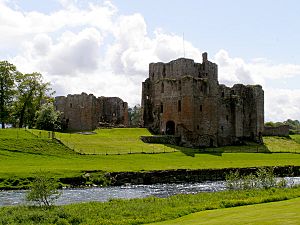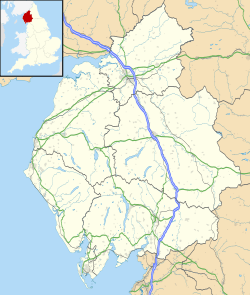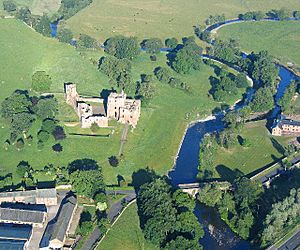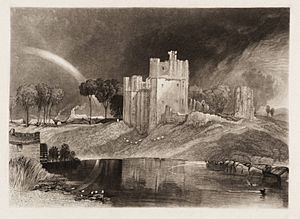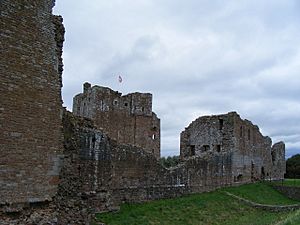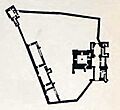Brougham Castle facts for kids
Brougham Castle is a fascinating medieval building located about 2 miles (3.2 km) south-east of Penrith, Cumbria, England. It was built in the early 13th century by Robert I de Vieuxpont. The castle stands on a special spot where the Eamont and Lowther rivers meet. This location was first chosen by the Romans for a Roman fort called Brocavum. Today, the castle and the old Roman fort are protected as an Ancient Monument.
When it was first built, Brougham Castle had a strong stone keep (the main tower). It was also protected by an earthen bank and a wooden fence called a palisade. Robert de Vieuxpont was one of the few powerful lords in the area who stayed loyal to King John. The Vieuxpont family owned other castles too, like Appleby and Brough.
Later, in 1264, Robert de Vieuxpont's grandson, also named Robert, was accused of being a traitor. His property was taken by King Henry III. But Brougham Castle and the other estates were eventually returned to the Vieuxpont family. In 1269, the estates passed to the Clifford family through a marriage.
When the Wars of Scottish Independence started in 1296, Brougham Castle became a very important military base. Robert Clifford began making the castle much stronger. He replaced the wooden defenses with impressive stone walls and added a large stone gatehouse. The castle was so important that King Edward I even visited it in 1300.
Over time, the Clifford family spent less time at Brougham. By 1592, the castle was falling apart. However, Lady Anne Clifford inherited the estates in 1643 and worked hard to restore Brougham and her other castles. After Lady Anne's death in 1676, the castle was kept in good condition for a short time. But then, Thomas Tufton, 6th Earl of Thanet, who inherited the estates, sold all the furniture in 1714. The empty castle was left to decay because it was too expensive to maintain.
As a ruin, Brougham Castle became a source of inspiration for artists and writers. It was painted by J. M. W. Turner and mentioned in poems by William Wordsworth. In the 1930s, the castle was given to the Ministry of Works. Today, English Heritage looks after this historic site, and it's open for everyone to visit.
Contents
Why Was Brougham Castle Built Here?
The spot where Brougham Castle stands has been important for a very long time. The Romans built a fort called Brocavum here. It was at a crossroads of three Roman roads. The nearby rivers, Eamont and Lowther, provided natural defenses. The land was also good for farming.
A small town grew around the Roman fort. When the Angles arrived, they named the place Brougham, which means "the village by the fort." After the Romans left in the early 5th century, the area became quite wild. There's no proof that Brougham was fortified again until much later.
In 1092, King William II took control of Cumbria. He set up a new border far north of Brougham. Carlisle Castle protected this new border. Other castles at Appleby and Brough protected the routes from Carlisle to Yorkshire.
In 1203, King John gave the land, including Appleby, Brough, and Brougham, to Robert de Vieuxpont. Robert was one of King John's favorites. He was one of the few lords in northern England who remained loyal to the king. Around 1214, Vieuxpont gained control of even more land, including half of Brougham. It was in this time of unrest that Brougham Castle was founded.
How Did the Vieuxponts Build the Castle?
Robert de Vieuxpont was a strong supporter of King John. He likely started building Brougham Castle as soon as he got the land. At first, the castle was surrounded by an earthen bank and a wooden palisade. The first three floors of the stone keep (the main tower) were built during this time. You entered the keep through the first floor, using a smaller building called a forebuilding. To the east, there was another stone building, probably a hall.
Building with stone was very expensive and took a long time. We don't know exactly how much Brougham Castle cost to build. But we know that other stone keeps from that time, like Peveril Castle, cost around £200. A much larger castle, like Château Gaillard, could cost £15,000–£20,000 and take years to finish.
In 1216, a Scottish army invaded the Eden valley. Alan of Galloway took over Westmorland. Brougham Castle probably wasn't finished yet, so it didn't help defend the area. Building work likely stopped until Alan left in 1217. Robert de Vieuxpont used money from the king's taxes in Cumberland to help pay for the castle. He probably used stones from the old Roman fort to build the castle.
When Robert de Vieuxpont died in 1228, his son John was too young to inherit. So, the castle was looked after by a guardian. John de Vieuxpont died in 1241, still too young to take control. His son, Robert, was also too young. This meant the family's lands were still under guardianship. During this time, the estates, including Brougham Castle, likely fell into disrepair.
When Robert de Vieuxpont finally became an adult around 1257, he inherited many debts. He joined other northern lords who rebelled against King Henry III in the Second Barons' War (1264–1267). Robert died in June 1264. Because he was seen as a traitor, King Henry III took his property. But in 1266, the king forgave Robert after his death. His two young daughters inherited the family estates. One daughter, Isabel Vieuxpont, married Roger Clifford. This is how Brougham Castle and Appleby Castle passed to the Clifford family.
The Powerful Clifford Family and Castle Changes
By 1269, Brougham Castle was owned by the Clifford family. In 1296, the Wars of Scottish Independence began. Robert Clifford played a big part in this war. Brougham Castle, being the furthest north of his castles, became his most important base. He spent a lot of time there.
During this period, Robert Clifford started a huge building project. He replaced the old wooden fence with a strong stone curtain wall. He also built a four-story stone tower called the Tower of League in the castle's south-west corner. A fourth story was added to the main keep, and a double gatehouse was built on its north side. A new stone hall was also built. This might mean there were more soldiers at the castle during the war, or it was built for a royal visit.
In July 1300, King Edward I, who was famous for building castles, visited Brougham. He brought many followers, including the Prince of Wales. Historians believe the king probably stayed at the castle. In 1309, Robert Clifford received a licence to crenellate Brougham Castle. This was permission from the king to fortify a site. It also showed that the king favored him.
King Edward I died in 1307. His son, Edward II, was busy with problems inside England. This allowed the Scots to raid further south. Around 1310 or 1311, Robert Clifford was given Skipton Castle. It was further from the Scottish border than Brougham. So, Clifford started spending more time and money building at Skipton.
Robert Clifford was killed in the Battle of Bannockburn in 1314. His son, Roger Clifford, was only 14 and too young to inherit. So, the Clifford estates were again looked after by guardians. Scottish raids caused so much damage that in 1317, the king gave Roger £200 to help maintain his castles.
Roger Clifford finally received his inheritance in 1320. But he was executed as a traitor in 1322. Brougham Castle was taken by King Edward II. In May 1323, a truce was signed between England and Scotland. This meant fewer soldiers were needed at castles in northern England.
When Edward III became king, Robert Clifford, Roger's younger brother, got most of the confiscated lands back. By 1333, Robert controlled all the lands that once belonged to the Vieuxpont family.
Wars between England and Scotland started again in 1332. Edward Balliol invaded Scotland. When he was forced out, he stayed with the Clifford family at Appleby, Brougham, Brough, and Pendragon castles. Robert Clifford wasn't heavily involved in the fighting. But when he died in 1344, his property was suffering from the war. Brougham Castle was in disrepair.
Two more young heirs followed. Then, Roger Clifford, 5th Baron Clifford, became an adult in 1354. A new truce was signed in 1357, lasting until 1384. Roger Clifford spent a lot of time at Appleby. But he also rebuilt the living areas at Brougham Castle, including the hall. He was ordered by the king to keep soldiers near the Scottish border, and some were likely stationed at Brougham. This need for more space might be why he rebuilt parts of the castle.
In August 1388, the Scots attacked England. One force raided the west, reaching as far as Brough. During this attack, Brougham Castle was briefly captured and looted by Scottish forces.
Roger Clifford died in 1389. The Clifford family started to lose interest in their castles in Westmorland. They preferred their properties in Yorkshire, as the Westmorland castles had been damaged by wars with Scotland. Brougham Castle wasn't used as a home again until 1421. During this time, the Clifford family had a rivalry with the House of Neville. Brougham Castle was likely kept with soldiers because it was close to Penrith, which the Nevilles controlled.
During the Wars of the Roses (1455–1485), the Cliffords supported the House of Lancaster, and the Nevilles supported the House of York. When the Yorkist King Edward IV took the throne in 1461, the lands of John Clifford, 9th Baron de Clifford were taken away. In 1471, King Edward IV gave Brougham Castle to William Parr. But a year later, Henry Clifford, John's son, was pardoned. When the Lancastrian Henry Tudor became King Henry VII, Henry Clifford asked for his family's estates back. This was granted in November 1485.
Henry Clifford lived until 1523. Under him and his son, also named Henry, who became Earl of Cumberland, the castle was sometimes used as a home. After Brough Castle was destroyed by fire in 1521, Brougham likely became the main center for the local area. Henry was not a popular landlord. When the Pilgrimage of Grace rebellion happened in 1536, Henry was a target. After being defeated, he retreated to Brougham Castle. After the rebellion was stopped, the way the government worked in the north-west changed. The Earl of Cumberland no longer controlled Penrith and Carlisle. Brougham Castle became the Cliffords' northernmost castle again.
Henry died in 1542, and his son, Henry Clifford, 2nd Earl of Cumberland, inherited the estates. During the Rising of the North, a rebellion against Queen Elizabeth I, Henry stayed loyal to the queen. He even took apart Appleby Castle to stop rebels from using it. He also offered Brougham to the queen's government, though there was no fighting there. Both the second and third earls, Henry and George, used the castle as a home. George Clifford was even born at Brougham Castle.
However, under George, the castle started to fall apart. By 1592, it was empty. George Clifford spent most of his time in southern England as the Queen's Champion. An inventory from 1595 showed that the castle was neglected and had very little old, broken furniture.
Lady Anne Clifford and the Castle's Revival

When George Clifford died in 1605, his wife Margaret became the dowager countess (a widow who holds a title). She started repairing Brougham Castle, which became her favorite home. Margaret had to fight off claims to the family estates from her brother-in-law, Francis Clifford, 4th Earl of Cumberland, but she kept Brougham Castle.
Her daughter, Lady Anne Clifford, continued restoring the castle and other Clifford properties. Anne was the only one of Margaret's three children to live past childhood. She inherited the Clifford estates after her mother died in 1616. But the inheritance was not easy. The Earl of Cumberland again claimed the estates. However, the king's privy council (a group of advisors) ruled in Anne's favor. This was only a temporary solution. In April 1617, the king decided that the Earl of Cumberland was the rightful heir, and the estates went to Francis Clifford.
Later that same year, King James I visited Scotland. On his way back, he stayed at Carlisle, Brougham, and Appleby castles. Expensive feasts were held in his honor, costing about £1,200. After this, Brougham was mostly forgotten and neglected by its owner.
Francis Clifford died in 1641. His son, Henry Clifford, 5th Earl of Cumberland, died in 1643 without a direct male heir. At this point, the Clifford estates returned to Lady Anne. The English Civil War began in 1641. Brougham was one of several castles in Cumbria and Westmorland that were held by Cavalier (Royalist) forces. The commander, Sir John Lowther, said he took control of Brougham not because it was important for war, but to stop the Parliamentarians from using it. Lady Anne used income from her estates to help maintain her castles during this time.
In June 1648, Appleby Castle was besieged for four days before giving up to the Parliamentarians. Brougham Castle, with fewer soldiers, fell easily to Colonel John Lambert. Many castles in the area were dismantled (damaged so they couldn't be used again). But Brougham was spared, probably because it wasn't seen as a key military target.
In 1650, Lady Anne Clifford began repairing Appleby and Brougham. Most repairs were done by 1653, but work continued for several more years. It cost an estimated £40,000. By this time, Brougham Castle was no longer a serious fort. It had become Anne's country home. She even created a garden on the site of the old Roman fort. This led to the discovery of Roman artifacts like coins and altars. A 10.5-foot (3.2 m) stone wall was built around the garden.
Brougham Castle as a Beautiful Ruin
Lady Anne Clifford died at Brougham Castle in 1676. Her grandson, Nicholas Tufton, 3rd Earl of Thanet, inherited the Clifford estates. He died in 1679. Over the next five years, ownership passed through his three younger brothers. Under the youngest, Thomas Tufton, 6th Earl of Thanet, Brougham Castle was especially neglected. In 1714, he decided that Appleby Castle was enough for him. He sold the contents of Brougham Castle for £570. Only the Tower of League was left untouched, but its contents were also sold in 1723 for £40.
By the 1750s, the castle's only practical use was as a source of building material for the village of Brougham. In 1794, a record noted that "much of the interior walls have lately been removed... for the purposes of building houses for the adjoining farmhold."
In the late 18th century, the Lake District became a popular place for visitors. The Romanticism movement made old ruins like Brougham Castle seem very beautiful and exciting. In his poem The Prelude, William Wordsworth wrote about exploring the ruins of Brougham as a teenager with his sister. Brougham also inspired another of Wordsworth's poems. The ruined castle attracted tourists and antiquarians (people who study old things). William Wilberforce described Brougham Castle as a "very fine ruin" in his diary. The famous painter J. M. W. Turner visited Brougham in 1809 and 1831. He made a sketch that later became a watercolor painting.
To stop the castle from decaying even more, Charles Tufton, 10th Earl of Thanet, spent £41 repairing it in 1830. His successor, Henry Tufton, 11th Earl of Thanet, did more repairs in the late 1840s, costing £421.
...That river and those mouldering tower
Have seen us side by side, when, having clomb
The darksome windings of a broken stair,
And Crept along a ridge of fractured wall,
Not without trembling, we in safety looked
Forth, through some Gothic window's open space,
And gathered with one mind in a rich reward
From the far-stretching landscape...
Henry Tufton died in 1849. The castle then went to the Hothfield family. Maintaining the castle was too expensive for them. By 1859, cows were kept in its gatehouse, and visitors complained that parts of the beautiful ruin were hard to reach. Without enough money, the castle quickly fell into serious decay.
In 1915, the Ancient Monuments Board said Brougham Castle was a monument of "national importance." With new bus services, more people started visiting the castle. In the late 1920s, about 2,000 people visited each year. In 1927, the 2nd Baron Hothfield gave guardianship of Brougham Castle to the Office of Works, though he still owned it. The organization repaired the castle for £5,925. In the 1930s, another £1,050 was spent removing stone added in the 1840s.
Brougham Castle looks much like it did after the main repairs in the 1930s. It is a Scheduled Monument, which means it's a "nationally important" historic building and archaeological site. It is protected from unauthorized changes. Until 1984, not much archaeological research had been done at Brougham Castle. A survey was then done as part of a detailed study of the castle's history and how it was built. Brougham is one of the few castles in Cumbria that has been studied so deeply by archaeologists. Today, the castle is open to the public, and English Heritage runs a museum there.
What Does Brougham Castle Look Like?
The path to Brougham Castle goes from east to west. To your left as you approach, you'll see the earthworks of the old Roman fort and where the 17th-century garden used to be. The ground is terraced, and to the north, the land slopes down towards the River Eamont. A moat (a deep, wide ditch) runs along the east, south, and west sides of the castle. It's between 10 and 15 meters (33–49 ft) wide and up to 3.4 meters (11 ft) deep. Even though the moat is dry now, it was probably filled with water in the past. The castle is shaped like an uneven polygon. It's about 68 meters (223 ft) long on the west side, 72 meters (236 ft) on the south, 48 meters (157 ft) wide in the east, and 54 meters (177 ft) on the north side.
You enter Brougham Castle through a three-story double-gatehouse. Originally, the coat of arms of Roger Clifford and his wife was carved above the entrance. But in the 19th century, Henry Tufton, 11th Earl of Thanet, replaced it with the current inscription, "Thys Made Roger." This inscription was originally above the entrance of the great hall built by Roger Clifford, 5th Baron Clifford.
The gatehouse was built in the early 14th century by Robert de Clifford, 1st Baron de Clifford. It has three parts: an inner gatehouse, an outer gatehouse, and a courtyard in between. The inner gatehouse still stands 12.5 meters (41 ft) high on the east side. The passage through the ground floor has an arched ceiling (vaulted). There was also a portcullis (a heavy gate that slides down) at the east end. A hidden postern gate (a small, secret door) was behind a buttress on the north side. This would have been a quiet way to leave the castle. The floors above the passageway each had one large room. They were connected to the keep, so people could move between them without going outside. In the 17th century, Lady Anne Clifford turned the top floor into her bedroom. The outer gatehouse also had a square shape, with one large room on each upper floor. It still stands 14.5 meters (48 ft) high on the east side. Below the outer gatehouse was a dungeon. On the ground floor, on the north side, was the guardroom. The large rooms in both gatehouses were used as living spaces. Although the very top of the gatehouse is gone, it would have had machicolations (openings for dropping things on attackers).
Next to the gatehouse is the 13th-century keep. A keep was the main living area in a castle, usually for important people. It was also the last place to hide if the rest of the castle was attacked. Brougham's keep is square and between 19 and 20 meters (62–66 ft) high, though it was originally taller. A spiral staircase in the north-east corner led to each floor, which had one large room. The garderobe (a toilet) was in the north-west corner.
For a long time, people thought the keep was built in the late 12th century because of its simple design. Square keeps with narrow buttresses and an entrance through a forebuilding were common then. By the 13th century, Brougham's keep would have looked old-fashioned compared to the round or polygonal towers that were becoming popular. However, historian Henry Summerson believes it couldn't have been built earlier than the early 13th century.
The wooden floors are gone now, so we can only guess how the rooms were used. But the ground floor was probably for storage. The first floor was likely a hall and sleeping area for guards. The second floor probably had rooms for the lord. A fourth story was added in the early 14th century. You would have entered the keep on the first floor, through the east side where the forebuilding was. Even though the keep was very important, not much of the original building survives today.
South-east of the keep was the hall. Roger Clifford built this in the late 14th century to replace an older one. It provided space for the castle's soldiers, whose numbers grew during the Anglo-Scottish Wars. It was also where the lord would eat with his soldiers. The hall had large windows, which might have made it less defensible. But it's possible they had large wooden shutters. The kitchen, which served the whole castle, was in the south-east corner. Along the south wall were more living quarters, a well, and a chapel. The chapel was another addition by Roger Clifford.
In the south-west corner of the castle was the Tower of League, built around 1300 by Roger Clifford. It had more rooms for living. It also allowed defenders to shoot at enemies coming from the gatehouse. The tower was four stories tall, with one room on each level. Each floor had a garderobe and a fireplace, suggesting it was for important visitors. The tower's square shape was typical for such buildings in northern England at that time, like at Warkworth and Egremont. This was different from the rounded towers preferred in the south.
Castle Legends and Stories
The antiquarian William Stukeley visited Brougham Castle in 1725. He wrote down local stories about some "monuments of stone" south of the castle.
People in the area believed these stones were made by Michael Scot, a famous wizard. He was a monk from Holmcultram Abbey. They also thought that a giant named Turquin lived at Brougham Castle. There's even a tower there called Pagan Tower. The legend says that Sir Lancelot de Lake lived at Mayburgh Henge and killed Turquin.
Turquin, or Tarquin, is also linked to the ruins of Lammerside Castle nearby. Some folklorists connect him to another local giant, Hugh Cesario. But others believe he comes from Sir Tarquin, an enemy of Sir Lancelot in Thomas Malory's Le Morte d'Arthur. They think this story, which didn't originally have a specific location, became linked to north-west England because King Arthur was often said to have his court in Carlisle.
Images for kids
-
A portrait of the Lady Anne Clifford's family; she is shown in the left and right panels, aged 15 and 56 respectively. The central piece shows her parents, George and Margaret, and her two brothers who died in childhood.
-
Brougham Castle in mezzotint by William Say after J. M. W. Turner, 1825
See also
 In Spanish: Castillo de Brougham para niños
In Spanish: Castillo de Brougham para niños


